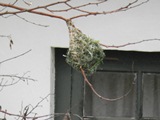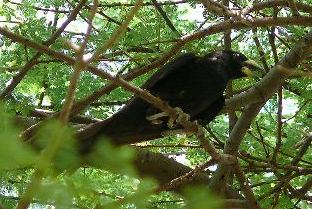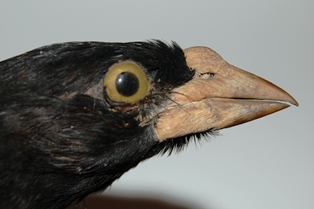Weaver species
Choose different species from drop-down list and press 'Go' button. See Full species list.White-billed Buffalo-Weaver Bubalornis albirostris
IUCN: Least concern Discovery: 026Categories: black, cooperative, long tail, acacias, fruit, frogs, baobab, Linnaeus, Gymnogene, pest, Bubalornis+Dinemellia,
News items about species
Discovery
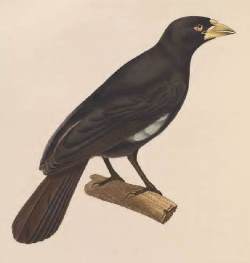
figure from Temminck 1828 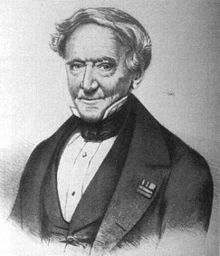
the White-billed Buffalo-Weaver 
distribution, type locality circled IntroductionThe White-billed Buffalo-Weaver was formally described by Louis Jean Pierre Vieillot, a French ornithologist. Vieillot also gave a French name to this species, ie. Le Gros-bec noir a bec blanc (meaning The black Grosbeak with a white beak).Vieillot described the plumage of the White-billed Buffalo-Weaver and listed it from Africa. The type locality was later restricted to Senegal, based on the amount of white in the wing of this species. This species was already described by Brisson 1760, based on specimens from coastal Africa, in the collection of Madame de Pompadour in 1754. Either Vieillot found these same specimens in the Paris museum and based his description on them, many decades later, or new specimens arrived from Africa. The first illustration of this species to be published, was by Coenraad Jacob Temminck 1828, based on a specimen in the Paris museum, from Galam in Senegal. Again, there is the possibility that this is the same specimen as that of Brisson 1760, although Temminck provided his own name for the species. Scientific citationCoccothraustes albirostris Vieillot 1817 Nouv. Dict. Hist. Nat., nouv. e'd., 13, p.535 Africa. Restricted to Senegal by Hartert, 1907, Novit. Zool., 14, p.485.Meaning of namesalbirostris Latin: albus, white; -rostris, billed.First English nameWhite-billed Nut-cracker (Swainson 1837) - for 2 decades authors used the French or Latin names of this species, before Swainson provided this name.Alternate namesAfrican ox bird, Black Buffalo Weaver, Kavirondo Buffalo-Weaver, Kenya Buffalo-Weaver.CollectorUnknown.Date collectedBefore 1817.Locality collectedAfrica. Restricted to Senegal.Type specimensType specimen probably in the Natural History Museum in Paris. |
The above is based on Weaver Wednesday 2, a weekly series about the discovery of each weaver species.
This species text first appeared as
Weaver Wednesday [143] - Discovery [26]: White-billed Buffalo-Weaver on 2015-03-11
1. Basic biology
The above is based on Weaver Wednesday, a weekly series about weaver species.
This species text first appeared as
Weaver Wednesday [28]: White-billed Buffalo-Weaver on 2012-12-26
2. Breeding facts
| Pair bond Polygynous; colonial Breeding season Jul-Sept throughout range; also Oct-Nov in some W African countries, mid Feb-Mar in Ethiopia and Eritrea; nest-building activity apparently stimulated by rainfall Nest site in thom trees up to 10 m above ground Nest building main structure built primarily by male, often stealing sticks from neighbouring nests, both sexes may add Iining material Colony size with up to ten individual nest-chambers Clutch size 2-4 Egg colour whitish or pale green to bluish, heavily blotched and spotted with grey and grey-brown (Nigeria), or plain to sparsely spotted with brown (Kenya) Egg size average for nine eggs in Nigeria 26.7 x 19.6 mm Incubation incubation of eggs by female only, no information on duration of incubation period Chicks and nestling period feeding of chicks by female only, no information on duration of nestling period; fledged young fed by both sexes |
Breeding information based on Handbook of the Birds of the World, Vol. 15.
3. Photos of Weaver Nests
 Vm 30175 |  Vm 29656 |  Vm 29649 | 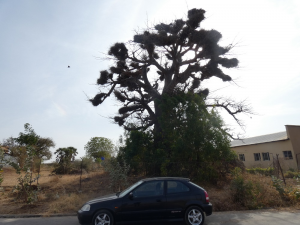 Vm 29554 | 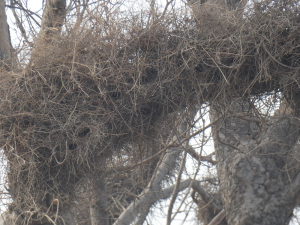 Vm 29553 | 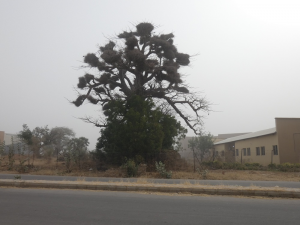 Vm 29552 |
Thumb-nails of most recent PHOWN records - click on one to see its full record
See all PHOWN records for this species here.
PHOWN (Photos of Weaver Nests) provides valuable info on breeding distribution and colony sizes of weavers.
You can contribute by registering and submitting photos at Virtual Museum webpage.
4. Breeding distribution
Google map showing distribution (For species with small ranges you need to zoom in at the correct area to see the range):
yellow blob - range of weaver species; read more about this here.
![]() - PHOWN records with photos
- PHOWN records with photos
![]() - PHOWN records with no photos (Nest Record Cards, other records)
- PHOWN records with no photos (Nest Record Cards, other records)
![]() - Birdpix records
- Birdpix records
![]() - comments on out of range records, or interesting records
- comments on out of range records, or interesting records
![]() - type locality
- type locality
CLICK on the marker on the map to see individual record details.
5. Range changes
Not South African speciesThe above is based on Weaver Wednesday 3, a weekly series about range changes in South African weaver species.
This species text first appeared as
n/a








